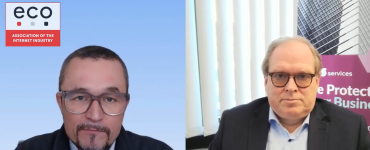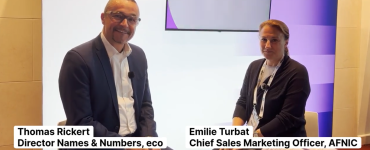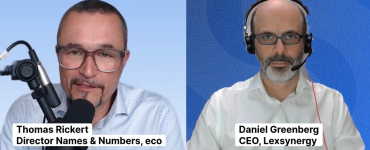eco sessions on the domain name industry
At WHD.global we had the pleasure to organize three panel discussions about some of the current hot topics in the domain name industry: “Building Towards Tomorrow’s Internet: Fixing IDNs, EAI & Universal Acceptance”, “brandTLDs – The Great Unkowns” and “geoTLDs – Added Value for Regions, Cities & Companies?”. We had a great audience, top class speakers and thank everybody who attended and joined us on stage.
Building Towards Tomorrow’s Internet:
Fixing IDNs, EAI & Universal Acceptance
Universal Acceptance was the topic of eco’s first panel session on 17 March at WHD.global. After a video explanation by Ram Mohan from Afilias, a lively panel discussion began, co-moderated by eco’s Lars Steffen and Christian Dawson from i2Coalition, and including Bert Hubert from PowerDNS, Peter Janssen from EURid, and Werner Staub from CORE.
Universal Acceptance remains a problem world-wide, according to the panel, not only for the new Internationalized Domain Names (IDNs), but also for many of the new generic Top-Level Domains – especially those longer than three characters. The Universal Acceptance Steering Group’s (UASG) own domain – www.UASG.tech – for example, is regularly rejected by portals and email clients as being an invalid address. As a result of being a 4-character TLD. Scripts that read from right to left also pose a major challenge. In fact, according to Lars Steffen, the UASG’s survey of UA-ready portals found only one single portal which is fully capable of accepting all of the new and potential domains: myspace.com. Clearly, there is still work to be done.
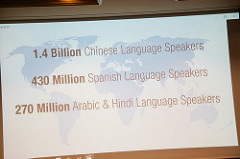
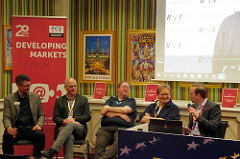
While Bert Hubert emphasized and reiterated throughout the session that UA is “not difficult” for software engineers to ensure readiness and acceptance of Unicode characters, he did end up conceding that some issues are complicated.
One of those, an issue raised by Peter Janssen from EURid – the registry for the .eu top-level domain – is actually not a technical problem so much as a redundancy problem resulting from the introduction of new Unicode international characters. Until recently, hardly any language-specific special characters were permissible in the second or top levels of domain names, which meant that certain consonants or vowels needed to be transliterated using the basic Latin alphabet. He gave the example of the German “Eszett” or “sharp s” (ß), which was represented by -ss-. When the Eszett became available in the Domain Name System, EURid took the decision to allow a domain name to be registered using either ß or ss, but not both – when one spelling is registered, then the other becomes permanently unavailable. Otherwise, competing companies could have near-identical URLs and customers wouldn’t know which web page they have landed on – or worse, the alternate spelling could be used for abusive purposes. This is also be the case with many other phonemes – like the final sigma in Greek, for example – and will increase as the further IDNs are launched.
brandTLDs – The Great Unkowns
The second panel session dealt with the in general public still relatively unknown phenomenon of the dot Brands. These have been quite slow in taking off, despite the fact that a number of them have long been approved by ICANN. The panel, moderated by Lars Steffen and consisting of registrars and consultants Achim Brinkmann from Nameshield Group, Benjamin Crawford from CentralNic Ltd., Martin Küchenthal from LEMARIT GmbH, Katrin Ohlmer from DOTZON GmbH, and Jannik Skou from Thomsen Trampedach GmbH, discussed what they see as the mains reasons for this and what they expect to see happening over the next year or so.
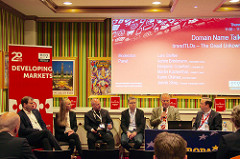
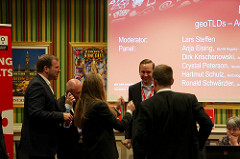
Firstly, all panel members agreed that Universal Acceptance is a major inhibitor for launching dot Brands. Brands need to ensure the wide-spread availability of their sites, and are concerned about the accessibility of the new TLDs. Equally, the approval process at ICANN has been taking so long that a number of brands had ceased to exist due to M&A activities, re-branding, etc., before a lauch was even possible – resulting in a lot of time, energy and money spent to no avail.
But there has also been a “wait and see” approach – many companies who got their dot Brands approved in the first round of applications have been watching the front-runners to see how successful their launches are and how well accepted the new TLDs are by users before taking action themselves.
Now there is gradual movement in the dot Brand sector. One example given by Jannik Skou is .bmw. For their centenary celebrations, the car manufacturer ran a campaign looking forward to the next hundred years. Their URL www.bmwgroup.com/de/next100.html was so unwieldy that the opportunity to exploit their dot Brand was taken, creating the URL www.next100.bmw. Now that the brands are starting to take advantage of the potential of the dot Brands, the panel members expect to see much more activity in the coming year. Equally, they are expecting a large number of applications for dot Brands to be made in the next round of ICANN applications, whenever that may be. Since the first dot Brands have appeared, enquiries for applications for new ones have increased dramatically.
Asked what their wishes were for ICANN, the panel members were unanimous in their three wishes: reduce the length of time to process applications and approve TLDs, reduce the paperwork and re-write the manual to be about a third of its current length, and reduce the costs. However, on this last point, a case was also made for keeping the costs high enough to discourage abusive use of domains.
geoTLDs –
Added Value for Regions, Cities & Companies?
The third and final session of the Domain Name Talks focused on the geoTLDs, and the speakers Anja Elsing from .RUHR Registry – regiodot GmbH & Co. KG, Dirk Krischenowski from dotBERLIN GmbH & Co. KG, Crystal Peterson from Neustar, Inc. (representing .nyc, .melbourne and .sydney), Hartmut Schulz from NetCologne GmbH (representing .koeln and .cologne), and Ronald Schwärzler from punkt.wien GmbH joined Lars Steffen on the podium.
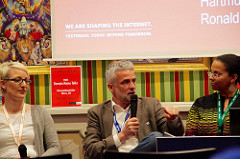
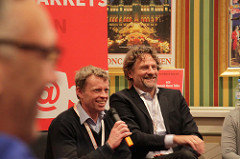
The speakers presented quite varied business cases, with .nyc requiring a registered address in New York City before approving a URL, and .sydney and .melbourne demanding demonstration of a relationship between the domain and the city. In contrast, the Cologne domains enjoy unrestricted availability. Positive and negative examples were given of companies outside of the city limits making use of the geoTLD: a small airport a considerable distance from Vienna – further than the city’s main airport – wanting to attract customers through the association with the city name; a pub in New York that sells Cologne-brewed beer under a .koeln URL.
All registrars reported good take-up of the geoTLD in their respective cities – the geographical reference is being seen by many local businesses as an advantage in their marketing. However, several of the cities report very slow progress with the city authorities – city governments are large institutions for whom a change of domain name would mean enormous costs for, for example, reprinting all printed material. Rather, the speakers expect to see a changeover occur in conjunction with a redesign of the corporate image at some stage in the future. Some city council services and programs have taken on the new geoTLDs, but these remain isolated cases with forward-thinking marketing managers. Again, the issue of Universal Acceptance raised its ugly head, with several panelists suggesting that the potential lack of accessibility of the new TLDs was inhibiting the take-up by city administration.
One point made by several registrars was that the cost of applying for a geoTLD is prohibitive, and many smaller cities simply cannot afford to do it. Again, the appeal was made for ICANN to reduce the costs of application and processing.
eco session at WHD – Domain Name Talks
- Building Towards Tomorrow’s Internet:
Fixing IDNs, EAI & Universal Acceptance - brandTLDs – The Great Unkowns
- geoTLDs – Added Value for Regions, Cities & Companies?
eco session at WHD – Doing Business in Germany…
- German Business Culture: Do’s and Don’ts
- German Business Culture: Dealing with the Law
- Surveillance in a Digital Society
- Market Consolidation: The German Data Center Market
- Outlook for the German Internet Industry –
Organic & Inorganic Growth Opportunities for Hosting Companies
You want to learn more about Universal Acceptance?
We have a Podcast about UA here.
Photos of the WHD.global sessions can be found here.


